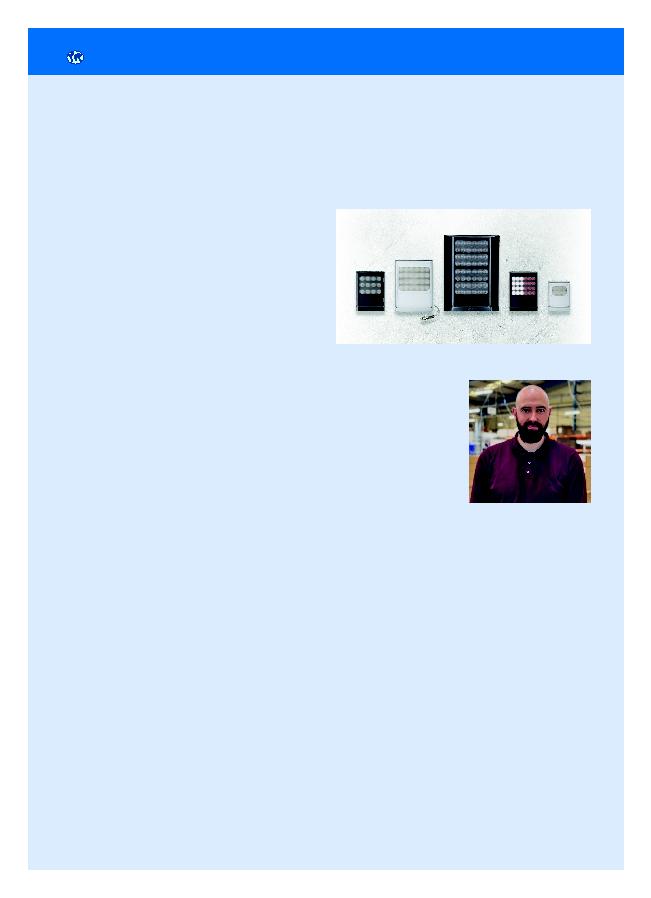
3 0 · d e t e k t o r i n t e r n a t i o n a l
Security News Every Day
www. securityworldmarket.com
3 0 · d e t e k t o r i n t e r n a t i o n a l
Special Feature: Perimeter Security
For perimeter applications using for example IP cam-
eras, PIR sensors, laser detectors and fibre optic fence
sensors, specifying an IP enabled illuminator capable of
providing an automated lighting response, is essential,
according to Callum Ryder, Product Manager at Raytec.
"If a PIR sensor detects movement from an intruder,
an alarm could be raised to automatically turn on the
white-light or put the lamps into deterrent mode", he
says.
Vario2 is Raytec's range of LED illuminators designed to enhance the performance of
any security system.
Callum Ryder, Product Manager at
Raytec.
The right lighting is crucial
for perimeter protection
Callum Ryder, Product Manager at Raytec:
Editor: Lennart Alexandrie
From critical infrastructure
to private property, perimeter
protection systems are used in
a wide variety of applications.
According to Raytec, all tend to
have common security goals: they
are deployed to restrict access,
detect and deter crime and protect
important assets. And there are key
things to consider when specifying
an illuminator for use as part of a
perimeter protection system.
Infrared and white light
Infrared (IR) illumination is the
most common type of light used
around a perimeter fence line. IR
emits zero light pollution (so not
to disturb the surrounding area),
but crucially, it allows the camera
to capture night-time images
covertly, without alerting potential
intruders or giving them light to
work by, Raytec stresses.
Callum Ryder says: "Once the
camera has detected an intruder,
the site may choose to raise an
alarm. This is where white-light
is often deployed; automatically
triggered as a flashing deterrent to
ward off an intruder, or used to
provide accurate positive identifi-
cation of the intruder."
He emphasises only using
white-light when it is needed
ensures light pollution is kept to a
minimum while still providing op-
timum levels of security. In some
instances, white-light may still be
chosen to illuminate the entire
perimeter, but due to light pollu-
tion, and the fact that the camera
is more receptive to IR, means
white-light is often preferred as a
deterrent.
Hybrid
Hybrid illuminators provide an all-
in-one solution, combining both
IR and white-light into a single
unit. This means one illumina-
tor can be used for both covert
surveillance, and as a white-light
deterrent. Hybrid allows the user
to control the wavelength and
switch seamlessly between IR and
white-light.
Quality and distance
Perimeter fence lines often cover
large areas, so distance and cover-
age of an illuminator is one of
the main things for a specifier to
consider. However, it is also equally
important to consider how the
illuminator will assist the camera
in obtaining the highest quality
images, Callum Ryder stresses.
"Illuminators able to deliver
longer distances may allow cost
savings by reducing the total num-
ber of illuminators across the site.
It may also allow the user to reduce
costs in terms of the numbers of
cameras, lighting columns, cabling
and other ancillary equipment
needed as part of the installation",
he says.
Hardware integration
For perimeter applications using IP
cameras, passive infrared sensors,
laser detectors and fibre optic fence
sensors, specifying an IP enabled
illuminator capable of providing
an automated lighting response, is
essential, according to Raytec.
"For example, if a PIR sen-
sor detects movement from an
intruder, an alarm could be raised
to automatically turn on the
white-light (so the intruder can
be positively identified) or put
the lamps into deterrent mode (to
ward off the intruder)", Callum
Ryder says.
Software integration
Raytec believes it is important to
choose an illuminator which can
be integrated with the security
management platform in use by
the site.
Callum Ryder says: "For ex-
ample, if a site is using Milestone's
Xprotect platform, the chosen
illuminator should be capable of
being integrated into that system,
so it can be controlled easily and
lighting responses set-up to be trig-
gered by other detection devices."
Camera analytics
Cameras with video analytics are
often used as part of a perimeter
surveillance system. Lighting plays
an important role in helping the
cameras to provide a consistent,
clear image.
One way to help ensure a good
image is to select an illumina-
tor which uses technology which
reduces hot spots and provides an
even image across the entire scene.
"Camera analytics will often
require increased light levels
compared to standard applications.
Even the best cameras will still
produce noisy images in dark-
ness that will seriously impact the
performance of camera analytics
and create false alarms. No light,
no camera analytics", says Callum
Ryder.
Lighting design
According to Raytec, lighting
design should be considered an
essential part of specifying lighting
for a perimeter security application.
"Undertaking a lighting design
helps to ensure the correct light
levels are achieved across the site
and are essential for cameras to
be able to capture high quality
images. For an installer, a lighting
design also provides a useful refer-
ence which becomes an important
document during the installation
and commissioning process", Cal-
lum Ryder concludes.

